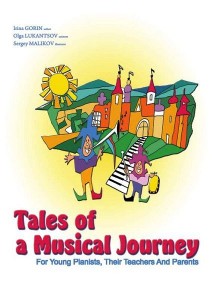Review: Tales of a Musical Journey
 Irina Gorin’s Tales of a Musical Journey starts a young beginner on a trek through an enchanted musical land called The Magical Kingdom of Sounds. Along the way, students meet King Meter, Fairy Musicalina, Princess Melody, Wizard Metronome, Prince Rhythm, King Jester, and Monster Claw.
Irina Gorin’s Tales of a Musical Journey starts a young beginner on a trek through an enchanted musical land called The Magical Kingdom of Sounds. Along the way, students meet King Meter, Fairy Musicalina, Princess Melody, Wizard Metronome, Prince Rhythm, King Jester, and Monster Claw.
As you can tell by the name of this series, it is all about sounds and how to make beautiful ones. This first book employs only non-legato sounds and fosters freedom of motion and flexibility of shoulders, arms, wrists, and fingers. A goal of the series is for the student to begin to recognize nuance from the very first lesson.
The two teacher DVDs illustrate how to develop touch and tone beginning with a single note and finger. The first step in the process is always Irina and the student making a new motion together—the child’s small hand inside Irina’s. (just in case you are wondering, Monster’s claws definitely do not make beautiful sounds.)
This series is also about rhythm, staff notation, and ear training. Rhythm is introduced with black (short sounds) and white (long sounds) circles and there are fun 3” round manipulatives with which to create rhythms.
Ear training begins with high and low sounds and includes listening to actual pieces (on the student CD) which illustrate each. Irina uses many pieces which the student will study in later years in early activities—Prokofiev’s March, Rebikov’s The Bear, and Kabalevsky’s Porcupine to name a few.
Staff notation is introduced through one line reading activities with line and neighbor notes. Stories help children with the concept of the Grand Staff as a place for high and low sounds.
Sadly the sounds could not sing songs that had more than three Sounds.
“We need more lines to fit all of our friends!” they complained to King Meter.
“I see”, responded the King. “I will call Fairy Musicalina for help. She has a knack for musical matters.”
When Fairy Musicalina came, she smiled and said: “I expected you would like my gift—musical line and I prepared even bigger surprise for you. I am going to give you TEN MUSIC LINES, so you can invite all the Sounds from the Magical Kingdom to live there.”
Notational symbols are presented along with pictures and stories as mnemonic devices. I particularly like the Princess’s Parrot who hides between the double bar line where his two eyes create the repeat sign and give away his hiding place.
There is writing required in many of the activities which could be a problem for some students. However, parents or teachers can easily have children point to the answers and then mark the page for them or guide their writing hands as Irina does when making new motions.
The included CD has music both for listening and playing activities. It is important to become familiar with the way each accompaniment fits with the student part. The count-ins are mixed percussion and it is not always obvious at first listen where the student’s beat is. There is no written guide to show how the parts fit together and student parts are not demonstrated along with the accompaniments on the CD or DVDs.
The two books in this series are meant to prepare the student to begin studying classical repertoire. Parental involvement is integral to the lssons and activities since they are written for 4-7 year olds. Young children’s attention varies from day to day and month to month as they grow and develop. There is much variety and the format of the books makes it easy to switch to a review or physical activity when needed. I think children will be captivated by these playful lessons, stay on task, and hardly know they are learning.


